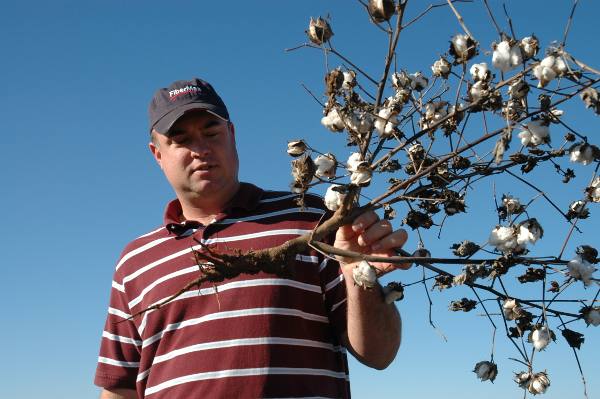
Southern Rolling Plains cotton farmers may have a viable option available in 2012 to control cotton root rot.Texas AgriLife Extension Service and Texas Cotton Growers with the support of Cheminova and Cotton Incorporated will pursue a Section 18 special use permit for Topguard (flutriafol) for root rot control in 2012.The T-band application method has been the most successful and will be the method pursued in the Section 18 request.

Southern Rolling Plains cotton farmers may have a viable option available in 2012 to control an old and costly nemesis—cotton root rot.
After more than six years studying various products and application methods, Texas AgriLife Extension integrated pest management specialist Rick Minzenmayer says the Texas AgriLife Extension Service and Texas Cotton Growers with the support of Cheminova and Cotton Incorporated will pursue a Section 18 special use permit for Topguard (flutriafol) for root rot control in 2012.
“The product performs well,” Minzenmayer told field day participants near San Angelo recently. “We’re fine-tuning application and rates.”
Minzenmayer and other Texas AgriLife researchers have tested various application methods on the John Wilde farm in Tom Green County for the last six years. They’ve evaluated application through subsurface drip irrigation systems, side-dress, in-furrow in front of the closing wheel, in-furrow as a T-band—part of the material put directly into the furrow and part placed two inches to the side—and banded behind the closing wheel.
The T-band application method has been the most successful and will be the method pursued in the Section 18 request.
“We figured out that side-dressing does not work,” Minzenmayer said. “The closer we get the material to the crown the better it performs.”
He said subsurface drip irrigation does not supply moisture consistently in the upper 4 inches to 6 inches of the soil profile. “We have to have moisture to activate the product,” he says. “The material works better with center pivot or furrow irrigation during dry years.”
Minzenmayer says applying all of the product directly into the seed furrow may create emergence and vigor problems if the soil gets too much moisture too soon after application. “If we get rainfall immediately after planting, the seed begins to absorb the material before it binds with soil particles. Imbibing too much of the product affects germination and vigor.
“By placing part of the material in the furrow and part to each side, we avoid germination and vigor issues,” he says.
Recommendations will include a 16-ounce to 32-ounce application rate applied in a T-Band using a flat fan nozzle. Minzenmayer says a total of 5 to 6 gallons of solution per acre were used.
“We still have a lot of hurdles,” he says. “We are finishing compiling data.”
He says one of the last remaining challenges is to prove efficacy and show a 20-percent or more yield increase to EPA and TDA. Efficacy is no problem. “But showing a 20-percent yield advantage in a drought year could be difficult.”
Cotton Incorporated and Cheminova have visited the research fields and are encouraged by results, Minzenmayer says. “Cheminova is excited about pursuing the label.”
So is John Wilde who has turned over a sizeable acreage to Minzenmayer and other researchers for the past six years. He’s kept that acreage, fields that are highly susceptible to root rot, in cotton so the team could evaluate various application methods and products.
“Rick has worked tirelessly for six years on this issue,” Wilde says. “This is one of the most important issues researchers can work on to increase cotton yields in this area.”
Minzenmayer says the Southern rolling Plains, where cotton root rot is most common in Texas, typically plants between 220,000 and 250,000 acres of cotton. “That’s a lot of potential for root rot infection,” he says.
Cost of the product is not known yet, Minzenmayer says, but the company has said it would be “reasonably priced.” They understand many of the acres affected by the cotton root rot are dryland and dependant on rainfall.
About the Author(s)
You May Also Like





